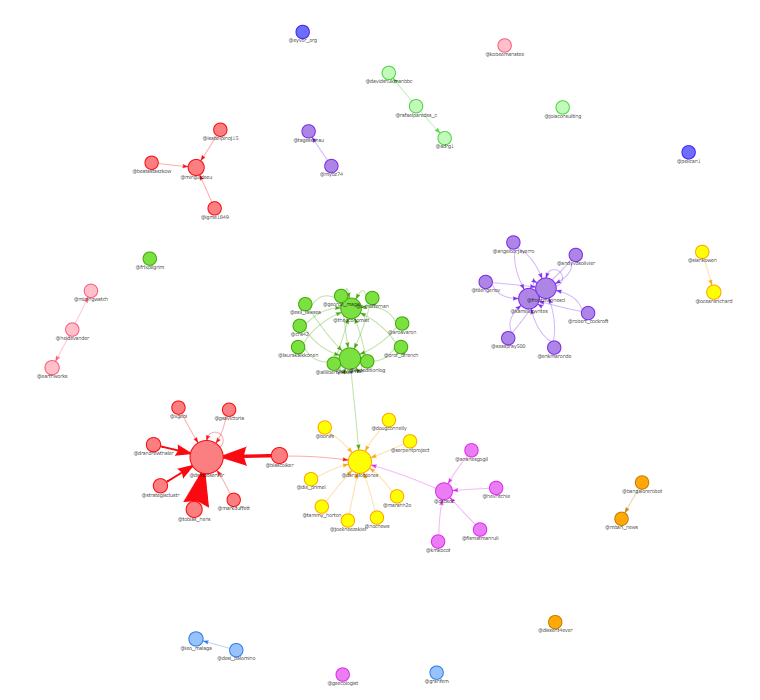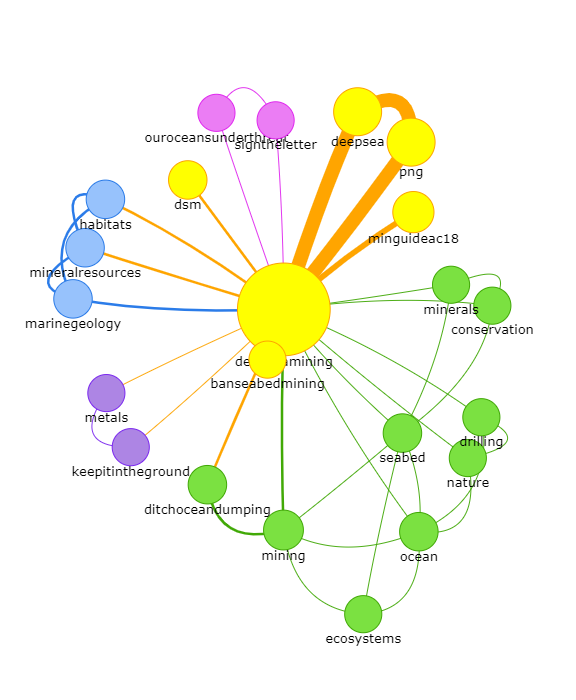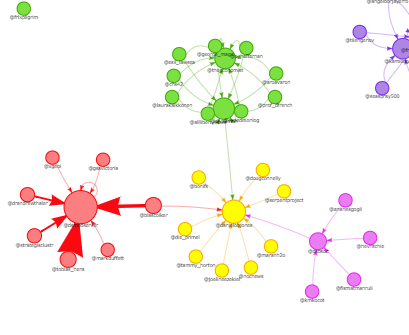Social media offers a snapshot of the human networks surrounding a particular issue. It makes public the conversations and relationships that once were hidden behind closed doors and over private phone lines. And, when the conversation is well-organized, it assumes keywords that make it searchable as well. What you see below is the snapshot of the people who have participated in a conversation using the hashtag #deepseamining in the last week (12/10/18 to 12/18/18) on Twitter. In terms of social networks of environmental or business issues, it’s fairly small, consisting of just 77 tweets. And yet, it offers a glimpse into the people of deep sea mining.

First, a quick primer on interpreting social networks: the dots, known as nodes, represent individual people participating n the conversation. The lines between nodes, known as edges, represent communication between those nodes, the arrow indicating the direction of that communication. The thicker the edge or the wider the node, the more frequent the communication. These social networks were mapped using SocioViz, a free resource available for anyone wishing to make some sense out of the social media data they are surrounded with every day.
Looking at the social network as a whole also shows different color clusters representing separate parts of the #deepseamining conversation. That is, the people involved in conversations using the #deepseamining hashtag did not overlap much, if at all. Clusters are fairly typical. In primary school, we would have called these cliques, and they’re a normal formation in society. However, there is real value attached to the people who can bridge two of the clusters – these people are known as boundary spanners.
Boundary spanners serve as integrators of information and often translators between clusters with different languages (literally and figuratively), and as such serve an important role in steering the conversation on a given topic. Here, @blascoiker and @dsbsoc are serving that role between the red, yellow, and lilac clusters. Boundary spanning is usually a hard-earned role, having to earn trust in two or more segments of the community
Another important role in a social network is a receiver – someone who collects a lot of information from many other members of the community. They are therefore in a good place to integrate the different streams of the conversation and provide a birds-eye-view of the conversation. Here, @dsmobserver, @danielobjones, @divaamon, and @theeconomist are serving as receivers. They are also transmitters, re-sharing their integrated knowledge out with the world. That’s hard to pick up because broadcast messages aren’t aimed at individual users, but you can see it in their tweets over the last week.
One can also look at a conceptual network of where #deepseamining fits into and overlaps other twitter conversations happening simultaneously.

This is a much denser network, suggesting the conversations are more frequently linked than individual users. There’s a frequent shared thread, indicated by thick edges, between #deepseamining, #deepsea, and #png, reflecting a geography of interest (#png is Papua New Guinea) and an importance to conversations about the deep sea in general. Here again, colors represent clusters of hashtags frequently used together in the same conversation.
Remember that these social networks are just a snapshot of the conversation – just on Twitter, and just in the last week. People can be fickle in their loyalty to a particular social media platform and attention spans are generally short. Yet, it is a slice of society that generally reflects broader conversations, especially newsworthy ones. So check back every once in awhile to see how the #deepseamining conversation is evolving.

